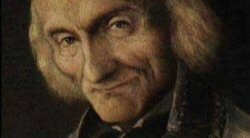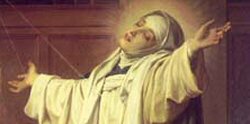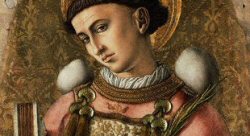Article from the Washington Post [comments by Fr. Zuhlsdorf from WDTPRS] Emphases mine - as I've said repeatedly, younger people ARE attracted to the Traditional Latin Mass, and more priestly vocations will come from those have become increasingly devoted to the reverence and beauty of the Extraordinary Form of the Mass.
Latin Makes a Comeback
Young Catholics Are Leading a Resurgence of the Traditional Mass
By Jacqueline L. Salmon
Washington Post Staff Writer
Saturday, November 24, 2007; B09
Parts of it are 1,500 years old, it’s difficult to understand, and it’s even more challenging to watch. And it’s catching on among young Catholics. [What does this opening remark say to you WDTPRSer in light of the entry I posted about the Novus Ordo as "easier" than the older Mass?]
It’s the traditional Latin Mass, [More journalists are beginning to make distinctions. Could they be reading?] a formal worship service that is making a comeback after more than 40 years of moldering in the Vatican basement.
In September, Pope Benedict XVI relaxed restrictions [called a "derestiction"] on celebrating Latin Mass, frequently called the Tridentine Mass, citing "a new and renewed" interest in the ancient Latin liturgy, especially among younger Catholics.
Spoken or sung entirely in sometimes inaudible Latin [How do you sing inaudibly?] by priests who face the altar instead of the congregation, [Thanks for avoiding the cliche!] it is a radical departure for most Catholics, who grew up attending a more informal Mass celebrated in their native tongue.
"It’s the opposite of the cacophony that comes with the [modern] Mass," said Ken Wolfe, 34, a federal government worker who goes to up to four Latin Masses a week in the Washington area. "There’s no guitars and handshaking and breaks in the Mass where people talk to each other. It’s a very serious liturgy." [Didn’t Archbp. Ranjith recently talk about a return to "seriousness"?]
And it is a hit with younger priests and their parishioners. [YES!]
Attendance at the Sunday noon Mass at St. John the Beloved in McLean has doubled to 400 people since it began celebrating in Latin. Most of the worshipers are under 40, said the Rev. Franklyn McAfee. [Famous as a frequent commentor of WDTPRS!]
Younger parishioners "are more reflective," McAfee said. "They want something uplifting when they go to church. They don’t want something they can get outside." [Yes… and encounter with something that is not ordinary.]
For some, the popularity of the service represents the gap between older Catholics, who grew up in the more liberal, post-Vatican II era, and their younger counterparts, who say they feel like they missed out on the tradition that was jettisoned in the move to modernize.
Although Chris Paulitz’s parents never questioned the switch to the "new" Mass, Paulitz and his wife, Diane, only attend Latin Masses.
After each such service, "you feel like you’ve learned something and you’ve grown a bit," said Chris, 32, in an interview after a recent Mass at St. Rita’s Church in Alexandria. [I return to the premises of the entry I posted about the Novus Ordo as "easier" than the older Mass! Nota bene "grown".]
Priests, musicians and laypeople are snapping up how-to videos and books, signing up for workshops and viewing online tutorials with step-by-step instructions on the elaborately choreographed liturgy. For example, the rubrics dictate that a priest must hold together the thumb and index finger of each hand for much of the Canon of the Mass, the central part of the liturgy that culminates with the consecration of bread and wine.
"I knew there would be some interest, but I didn’t know how quickly it would spread and how really deep the interest was," said the Rev. Scott Haynes, a priest in the Archdiocese of Chicago who started a Web site in August offering instructions in celebrating the Mass.
So far, the Web site, http://www.sanctamissa.org/EN/index.html, has received 1 million hits, [Lagging behind but doing well! o{];¬) ] Haynes said, adding that he receives several hundred e-mails a day from fans of the service. "I was surprised by how many people have latched on to this," he said.
Portions of the Tridentine Mass date back to the sixth century, but it was standardized at the Council of Trent in 1570—hence the name Tridentine. It was largely supplanted by the reforms of the Second Vatican Council in the 1960s, which modernized the Mass liturgy and translated it into modern languages.
The modern Mass, or Novus Ordo, can be said in Latin, [Again I return to the premises of the entry I posted.] but it is a radically different service from the Tridentine Mass. Until September, when the pope issued his Motu Proprio allowing greater freedom in celebrating the Tridentine Mass, priests who wanted to celebrate it needed special permission from their bishop, and it was celebrated at only a few churches in the Washington area.
In the Diocese of Arlington, where the bishop and priests are considered more conservative than in Washington, the number of churches where the service is celebrated has increased from two to seven since the Motu Proprio. The Arlington diocese, which stretches from Northern Virginia south to Lancaster and west to the Shenandoah, has sent six priests to a training center in Nebraska, at the Priestly Fraternity of St. Peter seminary, for an intensive seminar. [Excellent!]
In the Archdiocese of Washington, no more churches have added the Mass. Monsignor Charles Pope, who celebrates the Mass at St. Mary’s in Chinatown, thinks that it’s because of the number of parishioners demanding the Tridentine Mass is small. But those who want it "are very interested and very passionate about it," he said.
Priests who know the ritual are training other priests, and the diocese plans to offer training next year, said archdiocese spokeswoman Susan Gibbs.
But the service is not without controversy. Jewish groups have protested a Good Friday [How tiresome this all is.] prayer in the Mass that refers to the "blindness" of the Jews and calls for their conversion. Vatican officials have suggested that the prayer could be removed but have not done so.
For those who have fallen in love with the Mass, though, it is a part of what marks Catholics as unique among Christians. [YES! As I have been saying, Pope Benedict’s vision aims at reinvigorating Catholic identity!]
"Before Vatican II, there were a lot of things that marked Catholics as Catholic: the Tridentine Mass in Latin, fish on Fridays, those kinds of things," said Monsignor Kevin Irwin, dean of the School of Theology and Religious Studies at Catholic University. "And I think that 40 years after the [Second Vatican] Council, there is a revival of questions asking what is Catholic identity, and for some, this is an external manifestation of saying, ‘We’re Catholic.’ " [This guy gets it.]
At St. Rita’s Church, more than 150 worshipers listened and watched in silence as four black-and-gold-robed priests, accompanied by a half-dozen servers and a five-person choir, spoke and sang the hour-long liturgy. There was no homily, no English and no lay participation. [I protest! There certainly was lay participation! Every one of those people were participating, I’ll bet, though "active receptivity" to what the true ACTOR, the High Priest Jesus Christ, was doing in the words and gestures of the liturgy. Then those who were properly disposed, participated in the supreme manner of active participation by going forward actively to receive Holy Comunion.] In a throwback to the past, [Or a preview of the future.] some women wore lace head coverings.
In a crystalline tenor, the celebrant, the Rev. Paul D. Scalia, recited the Lord’s Prayer :
Pater noster, qui es in caelis: sanctificetur nomen tuum . . .
Our Father, who art in heaven, hallowed be thy name . . .
Scalia, St. Rita’s parochial vicar, added the Mass within days of the pope lifting the restrictions.
Scalia, 36, said he loves "the beauty of it, the silence . . . the antiquity. . . . It has a much more a contemplative feel to it. . . . This is the Mass that so many saints were raised on and themselves offered and prayed."
If you are actively discerning a vocation to the Priesthood, Diaconate, Consecrated Life, or Marriage and you are looking for information to help in your discernment, BE SURE TO CHECK the section at the bottom of the right sidebar for the "labels" on all posts. By clicking on one of these labels it will take you to a page with all posts containing that subject. You will also find many links for suggested reading near the bottom of the right sidebar. Best wishes and be assured of my daily prayers for your discernment.

Subscribe to:
Post Comments (Atom)























No comments:
Post a Comment